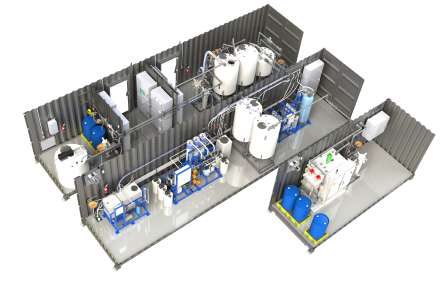electraCLEAR™ – Redefining Electrochemical Oxidation
Axine’s electraCLEAR stands as the pinnacle of electrochemical oxidation technology, representing over a decade of research and development. This advanced process incorporates innovative materials, treatment technology, process controls, and market-leading expertise.
Electrochemical oxidation, though sounding complex, involves immersing reactive electrode elements into the process stream and applying an electrical current to initiate treatment. A key innovation of electraCLEAR is its unique ability to utilize multiple different catalysts and electrode materials simultaneously within a single reactor. This groundbreaking design maximizes treatment performance, energy efficiency, and electrode lifespan. Supported by a suite of online instrumentation, Axine employs a proprietary machine-learning/artificial intelligence (ML/AI) algorithm for real-time monitoring and optimization of system performance and operating costs.
HOW electraCLEAR WORKS
The electraCLEAR treatment involves immersing conductive electrodes into a flowing process stream. By applying an electrical potential (voltage), electrons travel from the anode (negative electrode) to the cathode (positive electrode). The selection of electrode materials and applied current largely determines the process reactivity and chemical reaction pathways for treatment.

For challenging compounds like PFAS, electrons are directly transferred at the anode’s surface, initiating chemical oxidation. The oxidized contaminant can then react with hydroxyl radicals (*OH), ozone (O3), and various chemical radicals/oxidants generated in the process to enable degradation. Continuous water circulation, with adjustments to applied energy, ensures the desired treatment level is achieved.
Advantages of electraCLEAR
One of electraCLEAR’s key advantages is its ability to destroy contaminants down to elemental building blocks, such as dissolved carbon dioxide (CO2), nitrogen gas (N2), hydrogen gas (H2), oxygen gas (O2), and some dissolved mineral salts. The treated effluent can be directly discharged as there are no solid or liquid waste products, aligning with Axine’s commitment to environmentally responsible solutions.
